#the more I think about 1602 the more fascinated I become
Text
On a Tiktok of Avengers Loki impersonating Steve Rogers with Tony Stark right there, a commenter was like “Tony loves taking the piss out of Steve, if Loki wasn’t evil here I think they’d be besties” and someone else replied something along the lines of “defs somewhere else in the multiverse” and it made me giggle and got me thinking
One of my What-If related Marvel headcanons is that 1602 IS that somewhere, or at least, one of them. Loki is an eccentric theatre nerd who is out here with early access to the upcoming plays of “Will”, implying this little drama queen knows Shakespeare personally. Tony is an eccentric inventor who likes big made-up words. Shakespeare was also famous for making up words. Tony also says to Steve that he personally would’ve used a sonnet on Peggy. Shakespeare also wrote a bunch of sonnets. Loki likes to pop bottles while talking non-stop about theatre. Tony spent all night inventing on a bender, sooo they’re both a tad indulgent. I think the two of them are the only two not actually sparring with someone during the fighting that breaks out in the throne room (although Tony is trying to get his invention up and running - he’d probably fight if he could)
During my rewatch of this goofy little ep I absolutely LOST it spying a suspiciously Mjolnir shaped hammer/mallet in the back of Tony’s workshop, too. If actually Mjolnir, in this universe it belongs to Loki - who had coincidentally misplaced it when Thor ask him where it’s at. What’s Tony doing with Loki’s hammer, hm? How’d that get there? Theft? Forgetfulness? Or maybe a little prezzie?
You CANNOT convince me they don’t hang out, maybe secretly, passing goblets of palace sourced wine between them, Loki reciting his lines while Tony tinkers away, occasionally pausing to say something like “Where’s the blood, sweat and tears? Give me more, your highness. Also, can you put aside Yorick and hold these tongs for a mo’? Great!”
#the more I think about 1602 the more fascinated I become#also to find out it was inspired by Neil Gaiman Marvel comics!?!?#WILD#I’m a Loki Tony bond truther#Loki#marvel’s what if#what if season 2#loki tv#the avengers#tony stark#iron man#thor#frostiron#ironfrost#marvel#marvel cinematic universe#mcu#mwah.txt
49 notes
·
View notes
Text
2020
What a year, huh? Surely not anything anyone has expected to happen when we woke up on this day a year ago. I certainly haven’t. I’m not even sure, now, where to begin to sum up this year like I’ve done years prior. But then again... I may just as well just dive right into all the media I consumed this year, as I have done every year. I haven’t kept track as detailed as I have last year, but my year was definitely punctuated by pieces of entertainment that have come into my life.
Continuing on from 2019, my obsession with Good Omens was still going strong. Which was ideal, since I was gonna spend the first half of the year writing my Bachelor thesis on it. The intensity of the obsession may have waned a bit since, but I still love that show and book dearly and hold it close to my heart, and I don’t think that will ever stop. But while Good Omens was certainly an overall theme throughout my year, there were some other things that actually stood out.
With January came new episodes of Doctor Who, and having returned to that particular bandwagon the year prior, I was all about that. Jodie’s second season finally brought what I had longed for in her first--a darker kind of Doctor. She wasn’t quite as bubbly anymore, you could finally see some of the depths in the character that I loved so in the previous regenerations, which made me love Peter’s Doctor so incredibly much. In this season, I felt, Jodie was finally becoming the Doctor. Overall, that season catered to me personally every single episode. So many of the time periods they visited were of people I loved, and the introduction of Sacha Dhawan as the Master was absolutely....well, masterful. Sacha is brilliant in that role and I am utterly stunned by his talent. Although both John Simm and Michelle Gomez brought things to the Master that I liked, it’s Sacha’s completely unhinged take on it that made me finally like the character. He’s a madman and I love it.
The next major thing was The Good Place. I tend to have a talent of getting into shows just as they either ended their entire show, or the final season is just coming up. It’s happened quite a bit, and it was the same with this. I finally binged the show early in January and it would end its final season at the end of the month. True to form, I was completely obsessed with it for about a month, before I only occasionally thought about it again. But, thinking back now, I get this incredibly fond feeling for this show, and I remember that the finale absolutely wrecked me and I basically ugly sobbed through the entirety of it. Also very true to form, actually. I want to rewatch it again some time, but honestly preferably with someone who has never seen it before. Which, obviously, is a difficult thing to do given, well, everything.
Next up is something that surprised me a lot. In the middle of having to write my BA thesis, my procrastination thought it would be a great idea to rewatch and catch up on the entirety of Criminal Minds. And so I binged 15 seasons of that instead of writing my thesis. Which, coincidentally, had also just aired its final season not long before I started my binge in March. Rewatching this, I realised just how little I took in of the actual, like, stuff in the show when I first watched it as a teen. Although I mostly cared about the characters and their found family this time around--although I do find the cases really fascinating most of the time too--I noticed just how much I am not watching this for the fact that they are in the FBI. I was hyperaware of how often they shot at people before doing anything else, how many of the suspects died before ever being questioned or being brought in, and it made my skin crawl. I am aware how fucked up the criminal justice system is, and especially in the US, how the police functions and how incredibly glorified they are in the media. But rewatching this show, I realised how little I actually paid attention to anything when I was younger. Big yikes. Still, I remembered my love for these characters, and I really enjoyed that rewatch a whole lot. Found family will always get to me.
Once I finished writing my thesis and handed it in early in July, I then found my next momentary obsession: Community. The show had finally come to Netflix earlier in the year and a friend of mine had watched it then. I remember watching that pilot episode back then and being completely uninterested in watching it. The comedy felt like it wasn’t quite up my street, the characters were entirely unlikeable, and I especially disliked Jeff who the show was more or less centred around. I binged Criminal Minds instead, but then decided to give it another try. And, well, I watched it twice through without taking a break to watch something else in-between. Ironically, and maybe actually unsurprisingly, Jeff ended up being my favourite and I found myself relating a lot to him and his arc throughout the series. I even found myself writing some short ficlet-like things in the notes app on my phone. I made an attempt at starting a third watch, but I guess then the month was up, and my brain decided it was time for something else. My hyperfixations usually tend to die out after about a month. Which is why my complete devotion to Good Omens was a pleasant surprise. I did, however, end up watching quite a bit of Joel McHale and Ken Jeong’s The Darkest Timeline podcast throughout August.
Early in September, while already preparing for the new term at uni, and my first semester in my Master’s studies, I then turned to New Girl. Friends of mine had seen it and recommended it, and I remember watching probably the entire first season on TV while I was in San Diego the first time around back in 2016. Or at least I think it was the entire first season. Either way, I binged that whole thing, realised through Nick Miller that the go-to character I am drawn to and tend to project on in any piece of media is usually what I like to call “the garbage man,” which Nick is a prime example of. And although I spent a month watching the show in-between starting university again and volunteering at a film festival, I didn’t spend much time afterward thinking about it and moved on to other things rather quickly. I enjoyed watching it, that much I remember, and I’m pretty sure I cried at the finale because it was done wonderfully, but seeing as another month was up, my brain was probably like “okay fine that’s enough”.
I then spent most of fall and early winter watching every single bad Christmas movie available on Netflix, which was quite fun. In that moment of festivity, I also watched a movie I found absolutely brilliant and fell in love with immediately. It’s a beautiful movie called Jingle Jangle, it has a magnificent soundtrack and is absolutely incredible. I had no idea Forest Whitaker could sing and he completely blew me away. If you haven’t seen it already, I highly recommend it. It doesn’t matter that Christmas is already over, it’s beautiful either way.
By the time December finally rolled around, I was already over the whole Christmas thing, to be honest and I turned away from festive movies or shows, and eventually ended up finally picking up a gem I had heard much about and had been meaning to watch for a while. A show which, as it were, also aired its final season earlier this year. This little show is Schitt’s Creek. I will be going on about what this show means to me probably in another post at length, but for now just let me say: if you haven’t seen it, find some place to watch it, and put this beautiful show in your eyeballs. I am on my second run through already (although I’ve seen the second half of the show a second time already while watching it with a friend on their first run through), and it brings me so much fucking joy. It’s a gift, this show. And it will likely stay with me for a very, very long time.
That’s about it for the big things. I also watched a whole lot of other stuff, including entirely new things, or just newly released seasons of things I was already watching. Here’s what I can remember off the top of my head:
Charlie’s Angels (2020). The Night Manager. The Witcher. Dolittle (2020). The Librarians (rewatch). Harley Quinn (2020). Sonic the Hedgehog (2020). The Chef Show (S1 part 3, S2 part 1). Avenue 5. Money Heist (part 4). The Good Fight (S4). Brooklyn Nine-Nine (S7). DuckTales (2017 reboot). Frankenstein live. Staged (2020). Hamilton. Sense8. Julie and the Phantoms. The Boys in the Band. One Night in Miami. Enola Holmes. Supernova. His Dark Materials (S2). Happiest Season. The Great Canadian Baking Show.
I also got some reading done in-between what I had to read for my thesis in spring, and then for regular university courses in fall. Here’s some of what I can remember:
Anthony Horowitz, The House of Silk. Ramona Meisel, Sunblind. Donna Tartt, The Secret History. Good Omens novel and script book. Matt Forbeck, Leverage: The Con Job. Keith R.A. Decandido, Leverage: The Zoo Job. Greg Cox, Leverage: The Bestseller Job. Greg Cox, The Librarians and the Lost Lamp. Greg Cox, The Librarians and the Mother Goose Chase. Greg Cox, The Librarians and the Pot of Gold. Neil Gaiman, Marvel 1602. Christina Henry, The Lost Boy. Neil Gaiman, Norse Mythology. John Green, An Abundance of Katherines. Elizabeth Barrett Browning, Aurora Leigh. Maria Konnikova, The Confidence Game.
Having mulled over all this entertainment I consumed in 2020, there are also some non-tv or book things I need to point out. As many, many other people around the globe, I have also spent a large amount of time this year on my Nintendo Switch, playing Animal Crossing: New Horizons. It is a game I have waited for since the Switch was first announced, and I fell in love with it from the moment the first trailer dropped. It has brought me great joy in this weird fucking year, and I have more or less consistently played it since it came out in March. I ended this year with the in-game New Year’s Eve celebration and I feel like that summed up this year quite neatly and appropriately.
This year also brought with it another game very close to my heart: Super Mario Sunshine. With their release of Super Mario 3D All-Stars in September, Nintendo finally brought my all-time favourite Mario game to my all-time favourite console, and I played the entire game through in the first week of owning it, in-between university courses and volunteering at the film festival. Also contained in that package was Super Mario Galaxy which I have also played through in its entirety since. All that’s left for me now is Super Mario 64, which I am excited to play through in the coming year.
And to round off my year of entertainment, there are two more things I would like to mention. First, David Tennant Does A Podcast With..., which released its second season this summer. It is one of the only, if not the only podcast I keep up to date with and listen to immediately whenever a new episode drops. I’ve loved the first season dearly, and David came back with some incredibly fantastic guests for the second season as well. I can’t wait for what the podcast will bring in the future, but I will wait patiently until it is time. I can highly recommend it for everyone who likes interesting conversations between lovely people who clearly adore each other a whole lot.
And finally, while this year brought a whole lot of bullshit with it, it also gave me something I never thought possible and did not even dare to imagine in my wildest dreams. My all-time favourite show announced that it would be rebooted with the same main cast (minus one), a new wonderful member, and involvement of the original creators, and even started filming already in summer. Leverage is coming back. I still cannot believe it. I hoped for a movie, always. That maybe one day, they might bring the gang back together, for one last job, just one more encore. But to get a whole new tv-show with Aldis, Christian, Gina and Beth returning? With the addition of Noah Wyle? I can’t wrap my head around it. I am so excited for this. I predict that I will ugly sob through the entirety of the pilot episode, if not the first season, and will have to rewatch every episode because of it, but I have no doubt that it will be brilliant and wonderful.
True to form, I have now gone on about tv shows and movies for far too long, and haven’t really said anything about this year at all. 2020 was fucking weird. And I don’t think 2021 will be much different quite yet. I wrote an entire BA thesis in 2020. I successfully finished by Bachelor’s degree and started my Master’s studies and even got some excellent first grades in as well. I was lucky enough to be able to see some friends and family throughout the year, and even celebrate my birthday with a small circle of friends. I’ve become closer with friends, shared experiences I wouldn’t trade for the world, and, I think, maybe also grown a bit as a person.
I started this year excited to finally be able to start taking testosterone in February, and to finish the first part of my studies by summer. Although I did both of these things, they didn’t happen quite how I imagined them, but I am glad that I could do these things nevertheless.
2020 was a hell year, for sure. But there were some moments in there that I wouldn’t want to lose.
I’ve tried very hard to not be optimistic about this upcoming year, and rather take a more realistic, even pessimistic approach. But I can’t help but be hopeful. Hopeful that this year will be kind to us, and if it isn’t, that at least, we’ll be kind to ourselves and each other. It won’t be easy, and not much will change, I think. But we have to approach the coming time with kindness and compassion. That’s where I’m at currently. And I think that’s all for now.
Be well, friends, and take care.
#2020#end of year round up#personal#blog post#good omens#the good place#criminal minds#community#new girl#schitt's creek#schitts creek#jingle jangle#his dark materials#doctor who#leverage#leverage reboot#leverage 2#super mario 3d all stars#super mario sunshine#nintendo#nintendo switch#switch#super mario galaxy#super mario 64#university#david tennant#david tennant does a podcast with#animal crossing#animal crossing new horizons#acnh
12 notes
·
View notes
Text
Earth-199999
I was going to write a big thing about how to keep writing canon compliant fanfics while still keeping your favs after the whole Endgame thing went down, but then something happened and this whole concept bashed me in the head and so I’m going to ramble for a bit in a half-conscious state about the multiverse, the MCU, the designation “Earth-199999″ and just a bunch of thoughts. I hope it’s coherent.
I don’t know if this blew up as much on Tumblr as it did on Twitter, but ever since the Far From Home trailer dropped the “This is Earth-616″ line there’s been a bit of a fuss being kicked up (from myself as well, because listen - you can’t just throw around the designation “616″ and expect people not to react either positively or negatively in one way or another - the easter egg for it in Thor: The Dark World feels to me like where they should have left it but hey, that’s my opinion and isn’t as relevant to this post.) about the knowledge we as fans have been given for years that the MCU is Earth-199999. But what does any of it mean, and why should we care?
First let’s establish some things about the Marvel multiverse and why these numerical designations matter:
The Marvel multiverse has been around in comics for a long while - not forever, but long enough at this point that comics readers are likely to react quickly and easily to “Earth-616″. For those who are unaware, Earth-616 is the primary Marvel comics universe - this is the universe most people are referring to when they talk about comics and share comic panels (aside from that ever present female!Tony kissing Steve Rogers panel, or the panels lately of Sorcerer Supreme Doctor Anthony Stark who currently only has a TRN - a temporary reality number) and as such its history is fairly well developed, with a lot of classic and modern stories falling into it.
For comics fans when the multiverse comes up there are a couple of things that come to mind but most recently is likely the Time Runs Out / Incursion storyline for a lot of people. During this event, at the most basic level, a bunch of realities start to crash into each other and it’s a lot of mayhem. This invited short displays into some of the other realities and even eventually led to a lot of people meeting their other selves. It’s complicated to simplify, so I’m not totally sure why I’m trying, but I wanted to give a little context.
As for other realities? Well there are a few. Marvel Zombies is Earth-2149 in which the Avengers (and the world) become zombies during an early outbreak. Earth-311 is the 1602 universe in which we can see a lot of very time-period-y characters and set pieces. Earth-1610 is home to the Ultimates Universe, which is just its own big old bag of beans. But for the purposes of this post the only other one that actively matters is Earth-199999 - more well known as the Marvel Cinematic Universe.
What does Mysterio’s indication that their designation is Earth-616 mean?
Ignoring the “Earth-616″ specific designation, the more overarching questions seem to waver between “Are we going to see the multiverse for real, or is Mysterio lying his ass off?” and “Why have we been told it’s Earth-199999 for so long if that’s not the case?” and these are all fascinating questions to think about, and may give hope to those of us still struggling after the finale of Endgame - or at least give us fanfiction writers a lot of room to play!
First of all - we’ve already seen the multiverse for real. When the Ancient One “opened” Stephen’s mind in Doctor Strange we saw fragments of it everywhere and if you saw parallels between Stephen’s trippy dream sequence and things that happened in the Quantum Realm in Ant Man/Ant Man and the Wasp - that’s not an accident. You saw things you were supposed to see. Both of these are things that are meant to point and nudge towards early hints of the multiverse. Naturally Infinity War and Endgame both add further to this - Infinity War with Stephen’s snarky “Protecting your reality, douchebag” making it clear that Stephen deals with the multiverse already in some capacity, and the use of the Quantum Realm to slip through time (dimensions?), as well as the conversation Bruce Banner has with the Ancient One about branching timelines.
This doesn’t mean Mysterio isn’t lying his ass off in some capacity - but he’s definitely not bullshitting about the multiverse at least.
So then we’re left with “Why have we been told it’s Earth-199999 if it’s actually another designation?” And the answer I have to that is not a definitive (obviously) but speculation. I believe the Earth we’re used to and familiar with in the MCU really was Earth-199999 - but that the Earth things took place in from the moment they all returned from the Time Heist may not have been 199999 anymore, but a different Earth altogether.
What if the reality they jumped ‘back’ to was simply a reality divergence of their own? Based on what the Ancient One said about the stones themselves affecting the flow of time and whatnot. With the stones of another reality in play it’s highly likely that the reality was at the very least warped in some way - and for many of these stones they came from different realities.
With the way that fanfiction writers happen to write fics and how the multiverse works in Marvel in general, but specifically in the MCU if we take from what the Ancient One had to say a lot of fanfics become far more viable because who knows what tiny changes exist in this literal Alternate Universe?
I’m exhausted so I’m going to end this bit of speculation here, but who knows what this universe holds? Fanfic writers, I hope you’re all excited.
Keep your favs. Write what makes you happy. Write your angst, write your fluff, write your smut, just write whatever works because let’s face it - Marvel introducing the multiverse means we can all be correct.
#marvel#MCU#Meta#Earth-199999#Earth-616#marvel 616#Marvel 199999#Marvel Multiverse#Endgame#Endgame spoilers#Far From Home Trailer#Far From Home#Mysterio#MCU fanfiction#Fanfiction Things#Doctor Strange#Ant Man And The Wasp
16 notes
·
View notes
Photo

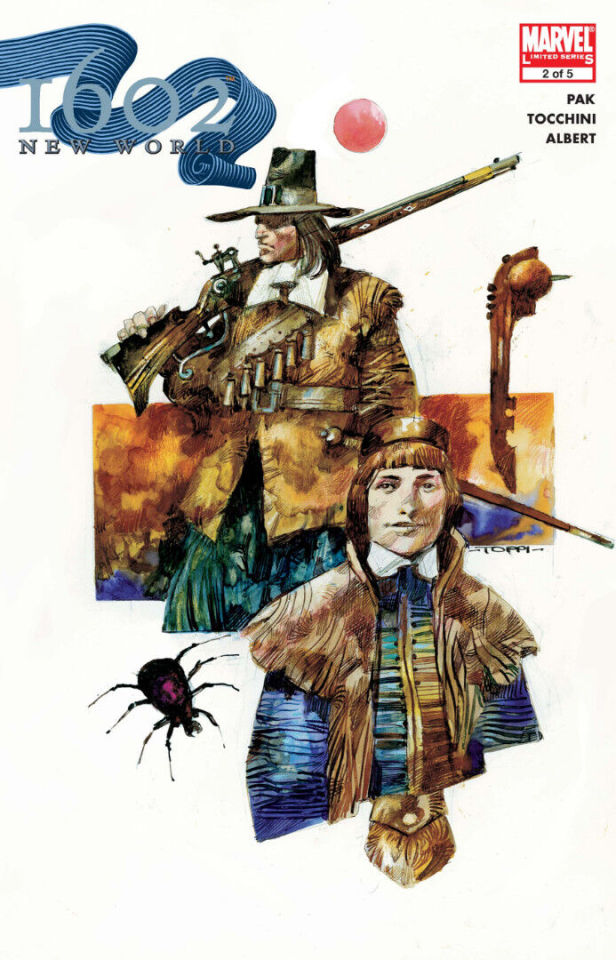
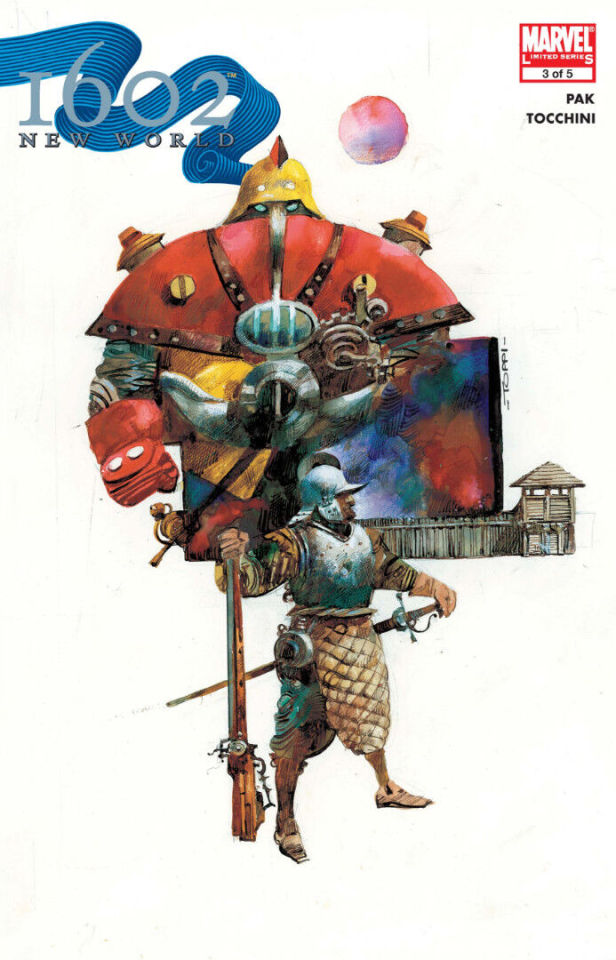
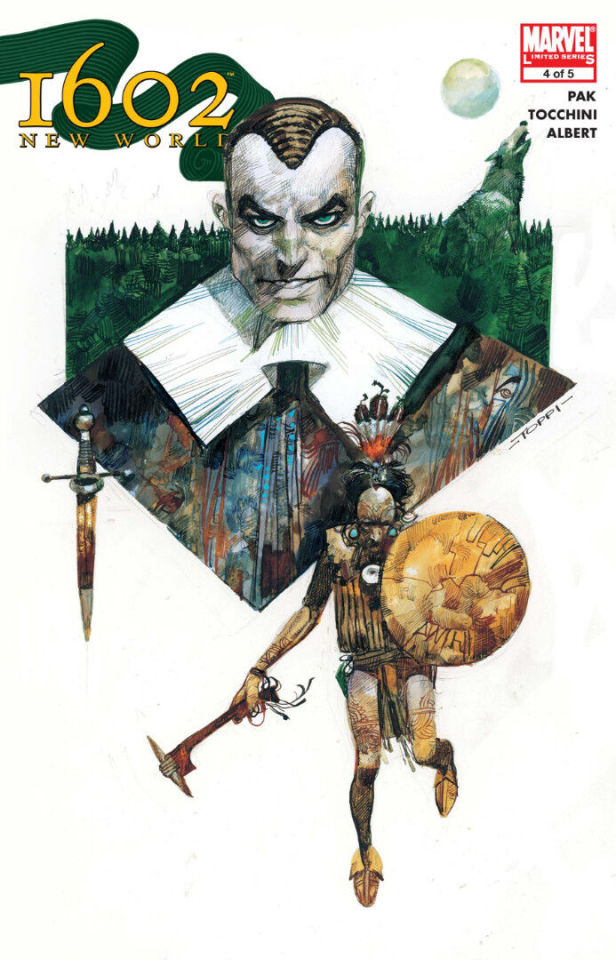

Comic Book Series Review-1602: New World (2005)
Publisher: Marvel Comics
Summary: Return to the world of 1602! Rising stars Greg Pak (X-Men: Phoenix -- Endsong) and Greg Tocchini (Thor: Son Of Asgard) pick up where the best-selling story by Neil Gaiman left off: America, the New World! When Captain America was thrust back in time, it changed reality as we know it. Dinosaurs still roam the earth, and the Marvel super heroes we know came to exist 500 years early. Witness David Bruce Banner and Peter Parquagh become the Hulk and Spider-Man in the most eagerly-awaited event of the year! Collects 1602: New World #1-5.
Writer: Greg Pak
Artists: Greg Tocchini, Mark Morales, Todd Klein, Sergio Toppi
Number of Issues: 5
This is perhaps the most interesting comic in the Marvel 1602 series outside of the original work. It deals with the exploration of the "New World" America, and they really take some creative liberties with what life there may have been like early on, even going as far as to add dinosaurs into the mix. This graphic novel steps the furthest outside of the box and feels the most like what you would expect a Marvel Comic to be without veering too far away from the primary concept.
The theme of intolerance against the different or unexplainable returns to the forefront in this narrative. It deals with the relationship between the white settlers and the natives of America as well as the Elizabethan witch hunts at the hands of King James I. It also deals with the common comic book trope of "secret identity". David Banner is the adviser to the King, whom is the greatest enemy of the supernatural, but he himself transforms into a being of supernatural origin.
By now you should be up to speed on the twist of the 1602 Universe and how it came to be. Uatu the Watcher interfered in human affairs. Earth-460 is an alternate future where Purple Man became the President of the United States and started executing and imprisoning superheroes. Captain America was set to be executed so Uatu the Watcher saved him by sending him into the 17th Century of Earth-616. That created the alternate timeline of Earth-311. Virginia Dare's bodyguard Rojhaz is actually Earth-460's Captain America. When he was transported to that world, it created a temporal rift and a destabilization of reality, that rift was known as "The Source". It's the origin of many of the unexplained happenings within this Universe. Master Osborne (Earth-313's Green Goblin) serves as the main antagonist of this story on his quest to find this source and the Natives that serve as it's guardians are his opposition.
While I actually enjoyed this series, I think the sequels to the original Marvel 1602 books highlight one of two things; either this concept isn't interesting enough to stretch across this many different stories, or those who took over where Gaiman left off just can't think of anything interesting to say about this time period with the use of Marvel's characters. I would have thought this venture would have given these writers a chance to really flex their creativity and tell stories a different way but it all feels very typical. Peter Parquagh isn't a very fascinating analog to the Peter Parker/Spider-Man character we are used to. He is almost a xerox except with the necessary changes made to his origin for this reality. That would be fine if the Spider-Man we already had wasn't the center of the Marvel Universe and he didn't have a ton of more intriguing stories for us to read. Greg Pak's handling of the Hulk is kind of the cornerstone of the New World saga but that's his wheelhouse.
Of all the titles that proceeded past Gaiman's vision, this one to me is the most memorable. The specific character focused stories don't bring enough interesting concepts to the table that weren't already there from the start. Pak does the best job of it but I think maybe 1602 is one of those ideas where they should have just left "well enough" alone.
THE GOOD
The original 1602 series didn't focus much on the characters I thought were the most interesting in the stories, Greg Pak (who is probably best known for his work on Hulk at this point) does alot of work with Banner and his Hulk persona and that was the character I connected with the most in these books. Although Parquagh isn't as interesting as his Earth-616 counterpart, Peter Parker...him being more of the focal point of this series allowed me to warm up to the character more and actually enjoy taking this journey with him through the New World.
Norman Osborn coming in as a strong villain was very much needed.
While some of the creative liberties taken with real life history were a little silly, I like that Pak actually took those liberties without stick so close to the parameters of reality. Some times the more you try and make something fantastical feel real, the more ridiculous and unreal it gets.
THE BAD
Like with the original series, I felt like more of our history could have been explored and more characters could have been used. This story is too centralized. The New World is bigger than Roanoke, Virginia and I would have loved to have seen more of the American colonies with these characters.
Although Pak's take on this Universe stepped a little more outside of the box...it still felt very by the numbers. There doesn't seem to be more to say about this alternate universe that wasn't really covered in the original series. I mean, it was good to see the New World and there was definitely more story to tell but with such rich material, I expected there to be more to explore here.
I give this series an,
8.0 out of 10
PRETTY GOOD
1 note
·
View note
Text
Skipping along the Surface: Exaggeration in the Antebellum Era

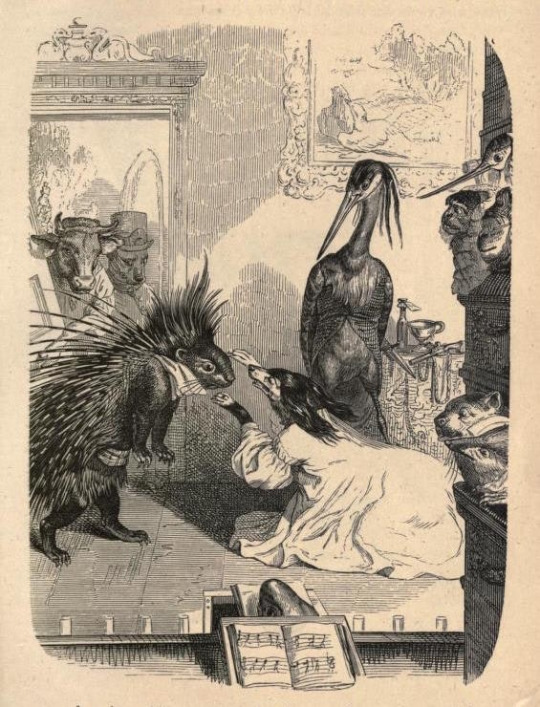
Illustrations from a collection of animal fables, The Public and Private lives of Animals from 1877. Source.
In the early half of the 19th century, the cities were where you wanted to be. An unexpected number of young people were suddenly packing their humble, rural lives and going to the city in hopes of wealth, social life, and to join the tail end of the industrial revolution.
From the moment people set foot in these utopias of stone and iron, the culture around them shifted. These people were no longer in their small towns where everybody knew everybody else (think Huckleberry Finn) instead they were in large cities, with streets full of bustling strangers (who you could never know every single of as more arrived daily). This caused a massive cultural shift in how people interacted with each other (not unlike our technological age), where people feared each other, the unknown, the stranger.

An illustration of a New York Street from the book “Nooks and Crannys of Old New York” (1899). Source
Granted, a fear of strangers has always been present, however there is a stark difference between a single carpetbagger (a lovely word I know) entering your small farming town and an entire street being filled with faces you don’t know. This fear of being unable to discern who can be trusted and who cannot from face alone, caused people to turn to Advice manuals, psuedosciences, and become interested in the externality of the human form with daguerreotype (a form of early photography) galleries, the “art” of Minstrelsy, and what the surface of the form tells. This use of Exaggeration of the human form in the 19th century, from Literature to the pseudoscience of Physiognomy to Minstrelsy, served as the surface of underlining societal fears and beliefs.
The term “Exaggeration” typically simply means, as defined by Merriam – Webster “an act or instance of exaggerating something, overstatement of the truth.” However, I will be asking you to, well, exaggerate the meaning a bit, to include any act twists the truth, draw excessive notice to certain aspects to something, or overall, to make a situation seem comedically unrealistic.
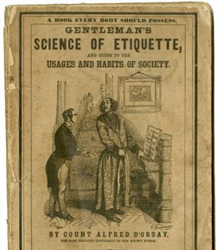

Count Alfred D’Orsay’s 1843 Help Manual on Proper Etiquette, Howe’s 1856 Complete Ball-room Hand Book. Source / Source
This mass migration of the youth to urban areas caused moralists to worry over how these young middle-class people separated from the “surveillance” of their families, towns, and churches would learn how to “properly” live life. Thus, this issue was solved by dozens of teachers, clergymen, and writers in the 1830s who published numerous manuals for living life, in an endless number of topics, like the ones pictured above. These manuals instructed young readers how to have proper manners, morals, appearance, good habits, along with more specific topics like proper dress, ball room dance, what to eat, when and whom to marry, among all other things (Haltunnen 1).
While some were simple etiquette books other manuals exaggerated the dangers of the city, likely only furthering this fear of strangers. While new arrivals were likely easy targets for what these authors describe as “Confidence Men” who preyed on trust, the descriptions of them and their influence was often fantastical. One manual stated, “The moment the inexperienced youth sets his foot on the sidewalk of the city, he is marked and watched by eyes that he never dreamed of” later on in the same passage, “There is she…who now makes war upon virtue and exults in being a successful recruiting-officer of hell.” (2)
These manuals would use words and phrases like “Seducer” and “Force of Evil” to describe the criminals in the cities, linking them to the devil and hell (as Christianity still held a firm grasp on people). Some even claiming the mere presence of these young people in the city can “corrupt them”:
“Feel as they may, contact with evil it is impossible to avoid. If they walk the streets of the city, or tread the floors of the hall, it is to see the sights, and hear sounds, and be subjected to influences, all of which, gradually and imperceptibly, but surely and permanently, are drawing the lines of deformity on their hearts” (5).
They would twist and exaggerate these conmen into masterful archetypal villains, cloaked in the shadows of the large city buildings. In the antebellum advice literature, the dramatic plot became an “inexperienced young man had just set foot in the city when he is approached by a confidence man seeking to dupe and destroy him” (3). This exaggeration of these conmen simply stood in because of people’s fears about strangers in this era (and their influence), along with the fears people had about being duped and deceptions.
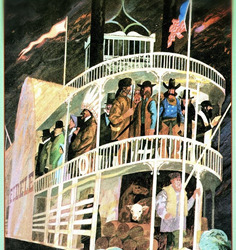
The Norton Critical Edition Cover for The Confidence-Man. Source
Herman Melville, famously known for Moby Dick, published a satirical book in 1857 about “Confidence Men” simply titled The Confidence-Man, commenting on people’s fears of these conmen and the general fear of “the other” people held. In this book, nearly every character is questionable regarding their motives, personality, and “truth” as it were, with very little description regarding them beyond appearance. Some characters only characteristic is their appearance, like “the man in the gray suit” who is a supposed charity man, making light of how people constantly questioned the people around them on surface level characteristics. The man in the grey suit makes a plea of charity, of confidence, to a rich man after explaining his dream of a “world-wide” charity fueled by the taxation of the entire globe:
"Eight hundred millions! More than that sum is yearly expended by mankind, not only in vanities, but miseries. Consider that bloody spendthrift, War. And are mankind so stupid, so wicked, that, upon the demonstration of these things they will not, amending their ways, devote their superfluities to blessing the world instead of cursing it? Eight hundred millions! They have not to make it, it is theirs already; they have but to direct it from ill to good.” (The Confidence Man, pg. 61)
The expanse and exaggeration of this scheme was obviously a prodding to the audience, as the man repeats the phrase “Eight Hundred Millions” to draw the listener back in time and time again as they get lost in his words. While this man is purposely left grey, he uses the language help manuals specified to “Confidence Man” later in the book egging a woman on by preying on her religion and morals. “"Entire stranger! …Ah, who would be a stranger? In vain, I wander; no one will have confidence in me… No one can befriend me, who has not confidence” He says, stretching a hand out to the woman in true or mock desperation, exaggerating his words so it seems he has no assistance in the world (despite the fact two other people gave money to him earlier in the book) (68). The book allows a fog to be cast over everybody, the conmen might be a singular conman in costumes, multiple conmen, or not conmen at all, it is up for the reader to decide after all.

Leonine specimens: Illustration in Giambattista della Porta’s De humana physiognomia (Naples, 1602). Source
This fear of strangers pushed people to figure out methods of determining who is “malicious” and “conniving” in the streets. What better place to turn than a pseudoscience entirely focused on outer appearance? Physiognomy is a pseudoscience about determining people’s inner characteristics by their outer appearance. It focuses on how people’s heads, features, and sometimes limbs are shaped, sized, and compared with themselves and each other. It is readily apparent why people in the 19th century readily enveloped this, choosing to exaggerate people’s appearance for the sake of satisfaction.
Physiognomy have roots dating back to 500 BC, where “Aristotle wrote that large-headed people were mean, those with small faces were steadfast, broad faces reflected stupidity, and round faces signaled courage”. In the 1600s, the first book regarding Physiognomy was published by Giambattista della Porta, believed to be the “Father” of the psuedoscience. The above illustration is from that book, comparing humans to animals (that one being a rather odd-looking lion), implying shared personalities. He guessed that humans have a “pure essence”, suggesting “that one could deduce an individual’s character from empirical observation of his physical features” (Waldorf).
Various books were published regarding Physiognomy in the 19th century, including Comparative Physiognomy: or, Resemblances Between Men and Animals in 1852 and Portraits of Patients from Surrey County Asylum in 1855. We can see the fascination of Physiognomy continue into the 1900s with books such as Vaught's Practical Character Reader from 1902, and The Physiognomy of Hands from 1917.


An illustration from Comparative Physiognomy, comparing “Negreos” to the profile of a fish, pg. 171. Source.
Comparative Physiognomy: or, Resemblances Between Men and Animals thus calls back to the first book of Physiognomy, comparing the human form to that of animals and implying shared traits with an emphasis on nationality. From simply reading the chapter list it becomes obvious there is some racial bias in play (Which comes all too easily to Physiognomy). Germans, Englishmen, and Prussians are compared to animals representing strength and cunning like lions, bulls, and cats while “Negroes”, Jews, and “Chinamen” are compared to prey and service animals like fishes, goats, and hogs. The book states, “Are not those half-closed, drowsy eyes, as seen in the portrait on the following page, a striking element of Chinese beauty?” and “The best point in the character of a hog is not a ravenous disposition, but simply a taste for anything and everything—an un-bounded appetite, perfect digestion, and great tendency to grow fat” (Redfield, 167-168).
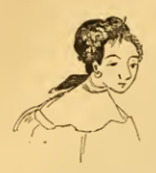

An illustration from Comparative Physiognomy comparing a portrait of a woman to that of a hog, pg. 167. Source
In the chapter that compares Africans to the fishes along their coast, the author states an interesting argument:
Catching negroes is akin to fishing, and the caught are stowed away on board vessels like cod-fish and whale oil; and were it not that they resemble fishes, and that there is a feeling of this, and a dim perception of it, the business would be perfectly infernal. There is always something to relieve men from the charge of being devils incarnate, and to place them in a position in which their reformation is not to be despaired of (81).
James W. Redfield, M.D. (the author of this strange fiction) implies, moreover states, that Physiognomy, the exaggerated dehumanization, enables them to conduct the act of slavery without being condemned in the eyes of god. By dehumanizing the people they are enslaving, comparing them to mere fish on a pole, it enables them to characterize the other. By exaggerating the African form, they enable themselves to follow the beliefs they hold, primarily the act of slavery.
It is curious then that Physiognomy manages to survive to our present day, from the stereotype of the “jewish” nose and exaggeration of African Americans lips, to my mother saying my hands are “piano players hands” to people being described as “mousey” to the term “stuck-up” which comes from Physiognomy thinking.
Various works of the time touched on the topic of Physiognomy either by using the pseudo-science, either seriously or satirically, reversing it as means of discussion, or using it as a means to explore identity. We return to our friend Herman Melville, as he forces the reader to use Physiognomy to decern people, primarily a character called “Black Guinea”. “Black Guinea” is described as “cut down to the stature of a Newfoundland dog; his knotted black fleece and good-natured, honest black face rubbing against the upper part of people's thighs” he later is continually being described as having a “Newfoundland-dog face”. This use by Melville is both a racial and Physiognomy comment, as “Black Guinea” is first treated as if he literally were a dog and later he is considered a conmen, a white man in black makeup (Melville, 13-25).
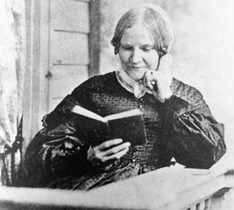
Lydia Maria Child in her older years. Source.
Lydia Maria Child, known for her skills at letter-writing and endeavors for racial justice, fights this pseudoscience by stating the “incongruities” plain in life. Child writes to an unknown, probably nonexistent, recipient about a Scotsman she met:
“A regular Sawney, with tartan plaid and bag-pipe. And where do you guess he most frequently plies his poetic trade? Why, in the slaughter house!...There, if you are curious to witness congruities, you may almost any day see grunting pigs or bleating lambs, with throats cut to the tune of Highland Mary, or Bonny Doon, or Lochaber No More.”
Alongside this, she talks about a sea captain, “Few have interested me more strongly than an old sea captain, who needed only sir Walter’s education…his familiarity with legendary lore, to make him, too, a poet and romancer” (Child, 58). By revealing these incongruities in life, she breaks this simplicity Physiognomy attempts to create, by showing a Scotsman playing beautifully in a place of slaughter, and a sea captain as a poet, a romancer of the masses (a slight jab at “Confidence Men” as well).
Walt Whitman, a poet famously attributed as creating the modern poem, also comments on Physiognomy. In his poem Faces he has lines “Do you suppose I could be content with all if I thought them their own finalé (truth)?” and “This face is a dog’s snout sniffling for garbage. Snakes nest in that mouth, I fear the sibilant threat” And later in, a whole stanza criticizing judging people from the surface:
“I saw the face of the most smear’d and slobbering idiot they had at the asylum,
And I knew for my consolation what they knew not,
I knew of the agents that emptied and broke my brother,
The same wait to clear the rubbish from the fallen tenement,
And I shall look again in a score or two of ages,
And I shall meet the real landlord perfect and unharm’d,
Every inch as good as myself” (The Portable Walt Whitman, 103-105).
Whitman argues that the exaggeration and focus on the human outer form, does not truly state the complexities a human has reducing them to, as he says, a “smear’d and slobbering idiot”. He says you cannot be content if you simply took people at face value, quite literally in this context.
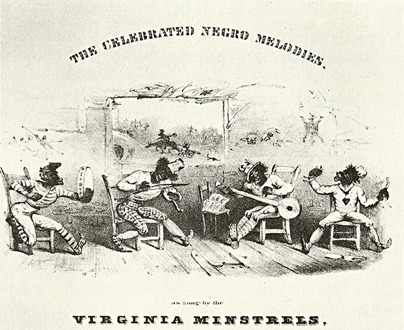
An advertisement for the Virginia Minstrels, a pioneer minstrel show company from 1843. Source.
Finally, exaggeration of the human form in this era is blatantly seen in the tradition of Minstrel shows, otherwise called Minstrelsy. Minstrelsy in the basic sense was white men in blackface, performing the enslaved African Americans dances and songs in an exaggerated caricature. Popular performers of this style were Jim Crow and Tom Rice (jokes on African Americans skin color and occupations). Minstrel shows were popular from the early 19th century, reaching its high point in the years 1850 to 1870. The advertisement above is from one of the most popular and pioneer minstrel groups, the Virginia Minstrels (“Minstrel Show”). This tradition typically had the performers exaggerating their lips and nose, performing a form of theatrical physiognomy.
Again, we return to our friend “Black Guinea” from Melville’s Novel, The Confidence-Man. A part of “Black Guinea’s” implied con is that he is accused of being a white man in black face. “He's some white operator, betwisted and painted up for a decoy. He and his friends are all humbugs” states a man with a wooden leg (Melville, 18). Prior to this, “Black Guinea” is acting extremely exaggerated as these minstrels would be, stating he lives “On der floor of der good baker's oven, sar” then reveals that the baker is the sun, and crawling around like a dog as stated previously. Additionally, he performs a popular minstrel act that readers in the era would know,
“Still shuffling among the crowd, now and then he would pause, throwing back his head and, opening his mouth like an elephant for tossed apples at a menagerie; when, making a space before him, people would have a bout at a strange sort of pitch-penny game, the cripple's mouth being at once target and purse, and he hailing each expertly-caught copper with a cracked bravura from his tambourine” (15)
This exaggeration is used to further cloud what “Black Guinea” really is, is he a crippled black man exaggerating his identity for the sake of the white crowd, or is he a white man in black face performing the illusion of blackness in exaggeration? The book never tells for sure.
Exaggeration in art has, is, and will always be a part of the process. As humans focus on certain aspects, those aspects get enlarged, spotlighted, exaggerated to the point their impossible to ignore. These exaggerations can reveal concerns and beliefs of that society, from the Antebellum help manuals fears of young getting conned, to Melville’s pessimistic satire on way people interacted, to cartoons depicting grown men as cowering children, to comparing humans to fish, to the overtly racist acts of Minstrel shows. These over-the-top, fantastical views of the world reveal to us, in the present, the society’s deepest beliefs and fears of the new age.
It is peculiar then how some of the Antebellum era manages to reflect our own, from the polarized political state, to the discussions of race as unanswered, silenced minorities seek a voice, to the new era of interaction we have over the metaphorical city of the internet. I may be making yet another exaggeration to add on top of the ones I have already shown. What can I say but, it is just another skipping stone along the surface of our culture.
Works Cited
Child, Lydia Maria. “Letters from New-York”. 1841. Pg. 58.
Halttunen, Karen. “Confidence Men and Painted Women : A Study of Middle Class Culture in America, 1830-1870.” 1982, pg. 1-5.
Melville, Herman. “The Confidence-Man: His Masquerade.” 1857. Pgs. 13-25, 61, 68.
“Minstrel Show”. Encyclopædia Britannica, The Editors of Encyclopaedia Britannica, September 2nd, 2020. https://www.britannica.com/art/minstrel-show
Redfield, James W. M.D., “Comparative Physiognomy or Resemblances between Men and Animals.” 1852, pgs. 81, 167-168.
Waldorf, Sarah. “Physiognomy, The Beautiful Psuedoscience.” The Iris, October 8th, 2012. https://blogs.getty.edu/iris/physiognomy-the-beautiful-pseudoscience/
Whitman, Walt. “The Portable Walt Whitman.” Edited by Michael Warner, December 30th, 2003. Pgs. 103-105.
0 notes
Text
All About Sleep
Sleep had been, until recently, the dark one-third of our lives and, like the far side of the moon, a persistent mystery for all humanity. As with all areas of mystery, it has become entangled with folklore and ritual. Known only indirectly through dimly remembered dreams and the drowsiness associated with falling asleep and awakening, sleep has always been linked with poetry, myth and time-honored superstition. None of us can study himself or herself while asleep nor converse with another who is asleep. But just as the space age has given us instruments to view the far side of the moon, nurturing a more sophisticated knowledge of our planetaryenvironment, so too has it given us the means to investigate, in a far less speculative manner, aspects of brain function leading to a more sophisticated knowledge of our inner environment: Questions regarding the kinds of sleep we are subject to, the variation in the intensity of this sleep, and even the very purpose of sleep can now be entertained. And it is precisely because of everyone's "indirect" experience of it that sleep lends itself so well to an exposition of the power, validity, and fascination of a scientific approach to the understanding of a human activity.
But it has not always been so that we have even appreciated the fact that the seat of sleep resides in the brain. That pillar of Greek enlightenment, Aristotle, attributed to the heart, and anatomically located there, the function of sense perception and sleep. It was not until the 13th century, during the late Renaissance
(according to a medical historian by the name of Dannenfeldt), that a philosopher named Albertus Magnus described the brain as the location where the vital spirit, derived from the heart, was "perfected," controlling the animal powers within and bringing about sensation and sleep.
Although interest in sleep and its problems has captivated all of us for years, much of what will be presented here is the result of more recent research. New information on nutrition and brainfunction, "chronobiology," differences in function between the left and right brain halves regarding thinking and dreaming, and new understanding of normal sleep patterns ... all these are examples of recent developments that will shed new light on our appreciation of sleepphenomena. The intent of this book is to be more than just philosophically interesting; it is expected to be of help to anyone with questions about sleep-related phenomena or problems.
A HISTORICAL PERSPECTIVE
People often judge the quality of their day-to-day living by the quality of their sleep. Consider how frequently you will hear people explaining their current mood state by referring to how they slept the night before. What goes into judgments of such quality? Many factors are known to impact on the nature of sleep. These include physical factors (such as living conditions andexternal circumstances in the sleeping environment), psychological factors (such as personality types and level of stress), and physiological factors (such as diet, physical activity, and generalstate of health). Early medical theorists like the ancient Greek authorities of Galen and Hippocrates speculated about the effect of various sleep positions and theorized about the effect of various combinations and permutations of hot food, cold food, liquids and, of course, the heavenly bodies, on the kind and amount of sleep that a person could expect. What they did not speculate about was the underlying, organismic basis for sleep to begin with. Their perspective did not leave room for any question about the very physiological "engine" that might be driving the sleep phenomenon.
Aristotle refined the thinking of the day regarding the effects of external events on sleep and how the body physiology was dependent on sleep. It was he who first speculated about a mechanism for sleep. In his Parva Naturalia, he concluded that "evaporations" from the digestive system produced sleep, perhaps drifting upwards like the swirling mists of the opium den. In many ways, reasoning along the lines of sleep being a phenomenon not integral to the body's physiology but visited upon it from the outside had its beginnings in early prescriptions for the number and ingredients of meals and the positions to be assumed during sleep. For instance, in his 1562 treatise Bulwarke of Defence againste all Sicknes, Somes, and Woundes, William Bullein wrote,
"... to lye upon the backe, with a gaping mouth, is dangerous: and many, thereby, are made starke ded in their sleepe; through apoplexia, and obstruction of the senews, of the places vitalle, animall, and nutrimentalle."
Another example of crediting external agents for the control of bodily processes can be seen in the writing of William Bailey, physician to Queen Elizabeth, who in A Briefe Treatise Touching the Preservation of the Eiesight in 1602, warned about sleeping in a room exposed to moonlight; such exposure, he opined, caused "rheumatic diseases." Incidentally, for all of these fascinating glimpses into the history of early medical speculation, I am indebted to the author Karl H. Dannenfeldt who, in 1986, published in the Journal of the History of Medicine and Allied Sciences an in-depth survey entitled "Sleep: Theory and Practice in the Late Renaissance." We do not have to look too far back into our past to note the popularity of the sleeping cap and then to see its antecedents in admonitions from the late 16th century that the head must be kept warm during sleep ... but not too warm. Dannenfeldt quotes the 16th century physician Vaughan's caution that if the head is kept too warm, "the excess heat would astonish the minde and spirit."
MIND AND BRAIN: BOTH SIDES OF THE LOOKINGGLASS
Sleep is a part of our lives, yet even today we have been in particular ignorance of it. Lewis Carroll used the metaphor of the Looking Glass, in Alice's adventures, to divide mental life into
sleeping and waking segments, and, further, to explore the interface between the two. I propose to shift the emphasis and usage of this metaphor in order to explore the subjective—objective interface of "mind" and "brain." Just as there were strange apparitions in Alice's looking glass that became more comprehensible upon closer acquaintance, there are in our looking glass hitherto inexplicable forms, such as neurons and chemicals, taking on more comprehensible shape as our scientific familiarity with them increases. Because of a series of scientific advances on a multitude of fronts that bear on this very personal topic, it is timely to correlate these findings from diverse disciplines and to demystify the phenomenon of sleep. In the process, perhaps a renewed appreciation for the power of the scientific approach to issues regarding personal existence will be instilled. These findings may then be contrasted to the narrow, fad-bound attitudes that govern so much of what is written on personal health concerns today.
Those of us involved in the medical sciences recognize that a scientific attitude toward a topic, such as a health concern, still permits considerable scope for imagination and speculation. Yetfor all that we might speculate about, we must submit to the discipline of distinguishing between what is known with reasonable certainty and what is merely plausible. Too many health cultshave grown up around a few facts formed into logically consistent but empty formulae that prevent the growth of new knowledge. The pursuit of more knowledge and deeper understanding is the essence of the approach of medical science. That previous scientific formulations have proved inadequate is to be taken as a matter of course. The search for new facts and greater understanding is a never-ending endeavor, and enough new facts will always overthrow old, revered theories, scientific or otherwise. It is expressly because of the breathtaking pace at which new information is being discovered that this presentation is necessary—for the rate at which excellent scientific theories become old and moribund, sadly, like scientific books such as this, is accelerating. A scientific theory, like a politician's term in office, serves to coordinate all theextant facts of life for that particular moment in time. When the facts of life change, so must the theories and political leaders. Because of the new pace of discoveries, no single theory can lastlong.
Perhaps this is why cultism seems to have made increasing inroads of late. How comforting to know from the cradle to the grave that the sign of the zodiac controls your fate. Anyway, medical science has been proven "wrong" so many times; besides, these scientists are always changing their minds!
By presenting a series of interdependent modules, however, each surveying an aspect of the sleepphenomenon, I hope to demonstrate that control over one's own sleep and health is bestachieved by opening oneself up to the wealth of new information that is flooding in. This presentation attempts to be a guide to this new information—an open-ended invitation to investigate and learn from a scientific perspective—rather than a close-cycle "how to" tract that purports to be the very last word and ultimate authority on the subject. If, after reading this, you find yourself more interested in learning new facts than in acquiring only a series of rituals to guide your sleep habits, my intentions will have been well served.
MODELS IN BIOLOGICAL PSYCHIATRY
This book breaks down the study of sleep into segments, each dealing with an aspect of sleep. In part, this is done in order to show how the investigation of an activity at different levels ofinquiry can be integrated so as to yield a meaningful and practical perspective. And while the data and concepts to be discussed here are specifically related to sleep, the general framework also applies to the study of other biobehavioral phenomena.
We are about to provide structure to a phenomenon that exists in that middle ground between biology and psychology, and between biochemistry on a submicroscopic scale and evolution on a cosmic scale. Sleep is such a phenomenon. But even as we dissect and examine the sleep—wake cycle from a number of different perspectives, we are creating a representation, sculpting a form,from an inner, stable armature on out. Like the evolutionary paleontologist reconstructing his papier mâché model of a long‐ extinct dinosaur, we will apply strips of information from different sources and build up, layer by layer, an image, a model that incorporates our knowledge to date about sleep.
0 notes